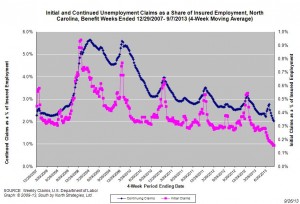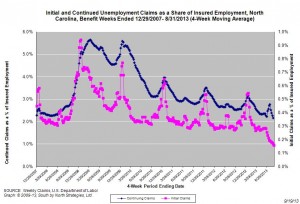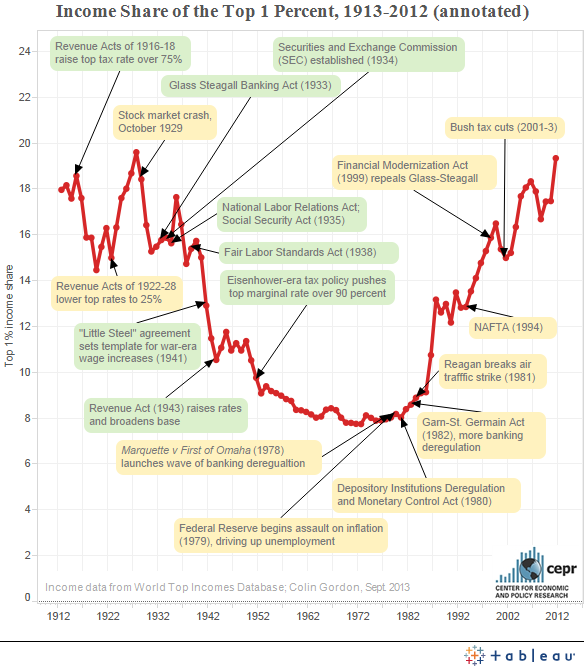Local Unemployment Rates Down Across NC
CHAPEL HILL, NC (October 2, 2013) – Between August 2012 and August 2013, unemployment rates fell in all 100 of North Carolina’s counties and in all 14 of the state’s metropolitan areas. Over that same period, the size of the labor force decreased in 78 counties and in 12 metro areas. These findings come from new estimates released by the Labor and Economic Analysis Division of the North Carolina Department of Commerce.
“Local unemployment rates have trended downward over the course of 2013,” said John Quinterno, a principal with South by North Strategies, Ltd., a research firm specializing in economic and social policy. “Unemployment rates nevertheless remain elevated, with 22 counties and one metro area posting unemployment rates of at least 10 percent. In August 2008, in contrast, seven counties and no metro areas had unemployment rates of at least 10 percent.”
Compared to December 2007, which is when the national economy fell into recession, North Carolina now has 2.8 percent fewer jobs (-115,700). In August, the state lost 1,700 more jobs than it gained (+/-0 percent). Since bottoming out in February 2010, the state’s labor market has netted some 5,050 jobs per month, resulting in a cumulative gain of 212,100 positions (+5.5 percent).
Between July 2013 and August 2013, local unemployment rates decreased in 98 of the state’s 100 counties, rose in one county, and held steady in one county. Individual county rates ranged from 4.1 percent in Currituck County to 15.2 percent in Scotland County. Overall, 22 counties posted unemployment rates greater than or equal to 10 percent, and 66 counties posted rates between 7 and 9.9 percent.
“Non-metropolitan labor markets consistently have struggled relative to metropolitan ones,” noted Quinterno. “In August, 9.2 percent of the non-metro labor force was unemployed, compared to 7.9 percent of the metro labor force. Compared to December 2007, the non-metro labor force now has 5.4 percent fewer employed persons, while the number of unemployed individuals is 63.1 percent larger.”
Over the month, unemployment rates fell in all 14 of the state’s metro areas. Rocky Mount had the highest unemployment rate (12 percent), followed by Fayetteville (9.8 percent) and Hickory-Morganton-Lenoir (9.1 percent). Asheville had the lowest unemployment rate (6.3 percent), followed by Durham-Chapel Hill (6.5 percent) and Raleigh-Cary (6.8 percent).
Compared to August 2012, unemployment rates in August 2013 were lower in all 100 counties and all 14 metro areas. Over the year, however, labor force sizes decreased in 78 counties and in 12 metros. In fact, the statewide labor force was 0.6 percent smaller (-28,882 individuals) in August 2013 than it was in August 2012. Among metros, Rocky Mount’s labor force contracted at the greatest rate (-3 percent), followed by Hickory-Morganton-Lenoir (-1.8 percent) and Fayetteville (-1.4 percent). With those changes, metro areas now are home to 71.8 percent of the state’s labor force, with 50.5 percent of the labor force residing in the Triangle, Triad, and Charlotte metros.
In the long term, improvements in overall labor market conditions depend on growth in the Charlotte, Research Triangle, and Piedmont Triad regions. Yet growth in these metros remains muted. Collectively, employment in those three metro regions has risen by 3.3 percent since December 2007, and the combined August unemployment rate in the three regions equaled 7.7 percent. That was down from the 9 percent rate recorded one year ago yet was well above the 6.3 percent rate recorded in August 2008. Of the three broad regions, the Research Triangle had the lowest August unemployment rate (6.8 percent), followed by the Piedmont Triad (8.3 percent) and Charlotte (8.4 percent).
The local employment report for August also provides insights into the effects of the extensive changes to the state’s system of unemployment insurance implemented over the summer. Last month, the number of regular unemployment insurance initial claims filed in North Carolina totaled 28,443, down from the 51,446 initial claims filed a year earlier (-44.7 percent). Mecklenburg County was home to greatest number of regular initial claims (3,155), followed by Wake (2,020), Guilford (1,570), Cumberland (1,287), and Forsyth (914) counties.
Between September 2012 and August 2013, North Carolinians received a (nominal) total of $2.3 billion in unemployment insurance compensation, down from the (nominal) $3.1 billion received between September 2011 and August 2012.
“Despite the passage of 3.5 years since the onset of a labor market recovery in North Carolina, local unemployment rates remain elevated throughout much of the state,” said Quinterno. “Recent declines in local unemployment rates actually are masking a number of alarming developments—developments that signal a labor market that is under-performing. The modest recovery that North Carolina has experienced in recent years appears to be stalling out in 2013.”
NC Unemployment Claims: Week Of 9/7/13
For the benefit week ending on September 7, 2013, some 6,296 North Carolinians filed initial claims for state unemployment insurance benefits and 75,334 individuals applied for state-funded continuing benefits. Compared to the prior week, there were more initial claims and fewer continuing claims. These figures come from data released by the US Department of Labor.
Averaging new and continuing claims over a four-week period — a process that helps adjust for seasonal fluctuations and better illustrates trends — shows that an average of 6,062 initial claims were filed over the previous four weeks, along with an average of 77,956 continuing claims. Compared to the previous four-week period, the average number of initial claims was lower, and the average number of continuing claims was lower.
One year ago, the four-week average for initial claims stood at 11,176, and the four-week average of continuing claims equaled 98,227.
In recent months covered employment has increased and now exceeds the level recorded a year ago (3.84 million versus 3.77 million). Nevertheless, there are still fewer covered workers than there were in January 2008, which means that payrolls are smaller today than they were more than 5.5 years ago.
The graph (below right) shows the changes in unemployment insurance claims measured as a share of covered employment in North Carolina since the recession’s start in December 2007.

Both new and continuing claims appear to have peaked for this cycle, and the four-week averages of new and continuing claims have fallen considerably. In fact, the four-week average of initial claims, when measured as a share of covered employment, is now at the lowest level recorded since early 2008. The four-week average of continuing claims also has fallen to the lowest level recorded since early 2008.
Note that the recent declines in new and continuing claims are not necessarily indicative of an improving labor market. State legislation that took effect on July 1, 2013, made major changes to insurance eligibility criteria, and the more stringent criteria eliminate claims that would have been valid prior to July 1. In time, this development also should reduce the number of continuing claims. Additionally, the legislation reduced the maximum number of weeks of state-funded insurance for which a claimant is eligible — an action that eventually should lead to a reduction in the number of continuing claims.
To place the numbers in context, consider how the four-week average of initial claims (6,062) was 45.8 percent lower than the figure recorded one year ago (11,176), while the average number of continuing claims was 20.6 percent lower (77,956 versus 98,227). Given the relative lack of improvement in labor market condition in North Carolina over the past year, such declines likely are products of changes to unemployment insurance laws rather than improvements in underlying economic conditions.
The Arc Of Inequality In America
A new infographic from the Center for Economic and Policy Research traces the share of total income going to the top 1 percent of the American income distribution from 1913 through 2012.
NC’s Labor Market Recovery Appears Stalled
CHAPEL HILL, NC (September 20, 2013) – In August, employers in North Carolina eliminated 1,700 more payroll positions than they added (+/- 0.0 percent). That drop was driven almost entirely by a net reduction of 6,400 jobs (-1.5 percent) on the part of local governments. So far in 2013, North Carolina has gained just 20,000 more jobs than it has lost (+0.5 percent), and the year is shaping up to be the worst year for job growth since the onset of the recovery.
These findings come from new data released today by the Labor and Economic Analysis Division of the NC Department of Commerce.
“North Carolina’s labor market turned in an underwhelming performance in August,” said John Quinterno, a principal with South by North Strategies, Ltd., a research firm specializing in economic and social policy. “No progress was made in closing the state’s large job gap, as what modest growth occurred in the private sector was erased by reductions in the public sector.”
In August, North Carolina businesses shed 1,700 more jobs than they added (+/- 0.0 percent). Last month, private-sector payrolls netted 5,100 positions (+0.2 percent), but public-sector payrolls shed 6,800 jobs (-1.0 percent), due almost entirely to cuts by local governments (-6,400, -1.5 percent). Within the private sector, the professional and business services sector netted the most jobs (+3,300, +0.6 percent), with all of the gain coming from the administrative and waste management subsector. Education and health services netted 2,900 positions (+0.5 percent), followed by the trade, transportation, and utilities sector (+2,800, +0.4 percent). The leisure and hospitality sector, meanwhile, lost the most jobs (-2,800, -0.6 percent), followed by the construction (-1,700, -1 percent) and other services (-1,600, -1.1 percent) sectors.
A revision to the July payroll data found that the state gained slightly more jobs than first estimated (+8,600 versus +8,200). With that revision, North Carolina now has, on net, 115,700 fewer payroll positions (-2.8 percent) than it did in December 2007. Since bottoming out in February 2010, the state has netted an average of 5,050 payroll jobs per month, resulting in a cumulative gain of 212,100 positions (+5.5 percent).
“North Carolina experienced minimal net payroll growth during the first eight months of 2013,” noted Quinterno. “The net gain of 20,000 jobs recorded during the first two-thirds of the year is 53.7 percent smaller than the figure netted during the first eight months of 2012. For North Carolina to net as many jobs in 2013 as it did in all of 2012, the state would need to net an average of 17,475 jobs per month for the rest of the year. At no point since 1990 has the state averaged such job growth over the final third of a calendar year.”
The household data for August also pointed to the existence of a sputtering labor market. Last month, the number of unemployed persons fell (-8,741, -2.1 percent), but so did the number of employed persons (-3,562, -0.1 percent).The drop in the unemployment rate to 8.7 percent—the lowest monthly rate posted since December 2008—therefore was attributable to people leaving the labor force rather than individuals finding new positions. In fact, the size of the state’s labor force has fallen steadily since December 2012 and is now smaller than at any point since January 2012.
The ongoing slides in two major measures of labor utilization provide additional evidence of an under-performing statewide labor market. In August, the labor force participation rate fell for the seventh-consecutive month. The current rate of 61.8 percent is the lowest monthly figure recorded at any point since January 1976. Similarly, the employment-to-population ratio fell again in August to 56.4 percent, a level only slightly above the 37-year low of 56.3 percent posted in late 2011.
August’s labor market report provides additional insight into the effects of the extensive changes to the state’s system of unemployment insurance compensation implemented over the summer. While the number of unemployed persons fell by 2.1 percent in August, the number of individuals receiving state-funded insurance compensation (new and continuing claims) fell by 8.5 percent from July to August. Additionally, the number of new insurance claims fell by 16.1 percent between July and August.
“North Carolina’s labor market has turned in an utterly underwhelming performance so far in 2013,” observed Quinterno. “The overall decline in the unemployment rate is masking a number of alarming developments—developments that point to a labor market that simply is under-performing. The modest recovery that North Carolina has experienced in the wake of the most recent recession appears to be stalling out in 2013.”
NC Unemployment Claims: Week Of 8/31/13
For the benefit week ending on August 31, 2013, some 5,700 North Carolinians filed initial claims for state unemployment insurance benefits and 76,180 individuals applied for state-funded continuing benefits. Compared to the prior week, there were fewer initial claims and fewer continuing claims. These figures come from data released by the US Department of Labor.
Averaging new and continuing claims over a four-week period — a process that helps adjust for seasonal fluctuations and better illustrates trends — shows that an average of 6,065 initial claims were filed over the previous four weeks, along with an average of 79,689 continuing claims. Compared to the previous four-week period, the average number of initial claims was lower, and the average number of continuing claims was lower.
One year ago, the four-week average for initial claims stood at 11,124, and the four-week average of continuing claims equaled 99,327.
In recent months covered employment has increased and now exceeds the level recorded a year ago (3.84 million versus 3.77 million). Nevertheless, there are still fewer covered workers than there were in January 2008, which means that payrolls are smaller today than they were more than 5.5 years ago.
The graph (right) shows the change
 s in unemployment insurance claims measured as a share of covered employment in North Carolina since the recession’s start in December 2007.
s in unemployment insurance claims measured as a share of covered employment in North Carolina since the recession’s start in December 2007.
Both new and continuing claims appear to have peaked for this cycle, and the four-week averages of new and continuing claims have fallen considerably. In fact, the four-week average of initial claims, when measured as a share of covered employment, is now at the lowest level recorded since early 2008. The four-week average of continuing claims also has fallen to the lowest level recorded since early 2008.
Note that the recent declines in new and continuing claims are not necessarily indicative of an improving labor market. State legislation that took effect on July 1, 2013, made major changes to insurance eligibility criteria, and the more stringent criteria eliminate claims that would have been valid prior to July 1. In time, this development also should reduce the number of continuing claims. Additionally, the legislation reduced the maximum number of weeks of state-funded insurance for which a claimant is eligible — an action that eventually should lead to a reduction in the number of continuing claims.
To place the numbers in context, consider how the four-week average of initial claims (6,065) was 45.5 percent lower than the figure recorded one year ago (11,124), while the average number of continuing claims was 19.8 percent lower (79,689 versus 99,327). Given the relative lack of improvement in labor market condition in North Carolina over the past year, such declines likely are products of changes to unemployment insurance laws rather than improvements in underlying economic conditions.



 Email Sign-Up
Email Sign-Up RSS Feed
RSS Feed